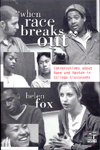So far, I have been frustrated by the process of defining Whiteness in this course. That is, I do not think that an adequate definition of the term has been discussed in class or offered in the readings. By "adequate definition" I mean to say, a definition which I find personally meaningful, and one which I think is helpful in identifying instances of White bias in my life, in education, and in Canadian culture.
James Frideres writes in his essay, Being White and Being Right: Critiquing Individual and Collective Privilege:
Once a particular perspective is built into the laws, norms and mores of a society, it becomes part of “the way things are.” As such, Whiteness is defined as part of the human condition and it defines normality. (44)
Running the risk of being labeled as one of the White “challengers” from Frideres’ classrooms, I cannot help but wonder how we are supposed to separate what is considered “normal” in Canada from what is uniquely “White” in Canada. Are the two ideas equivalent? What are the points of commonality in all races, and what are the particularities of White people? Being able to answer these questions is absolutely essential to identifying the latent systemic racism which exists in our society, and yet these are exactly the question that have not been addressed in Frideres’ essay. Saying that Whiteness is the “norm” is, I think, not really helpful when trying to identify specific social constructs which exhibit a bias towards White people.
To me, a helpful definition of Whiteness is one which is reached through careful self-examination, rather than one which is presented as given knowledge from an author to a reader. Only through an acute awareness of one’s own professional, political, social and religious prejudices can one ever hope to recognize and respect someone else’s professional, political, social and religious prejudices. Often for a White person, these prejudices will be in agreement with those most prevalent in Canadian culture, but then again, perhaps not. It is important to be able to identify what parts of one’s worldview coincide with the majority opinion and which parts do not, because realization of the points of convergence will help one to appreciate privilege, and realization of the points of divergence will help one develop a sense of empathy for others who are different. The result of this introspective approach is an understanding of Whiteness that is intimately tied to one’s own cultural identity, and is therefore much more meaningful and likely to galvanize the kind of social activism that is required to further the success of multiculturalism in Canada.
I would therefore ask two questions to James Frideres, following from his discussion of Whiteness on page 51. These questions are practical in nature, written from the perspective of someone who is struggling with the task of extracting meaningful information and insight from the course readings:
Colour-blindness is neither blindness, nor an inability to see colour. Rather, it is a refusal, or what is called “White resistance to seeing.” This resistance is learned and nurtured to protect the status quo that privileges White people and occurs on both the individual and systemic levels. At the individual level, it allows for teachers to absolve oneself of racism. The systemic level of colour-blindness denies the institutionally mandated privileges and discriminatory practices associated with ethnicity. It denies the system of rules, procedures, and beliefs that result in Whites collectively maintaining control.
Firstly, I would ask: When discussing the topic of White privilege with students and colleagues, is introducing Whiteness as an invisible construct propagated to preserve White privilege a wise way to start? Secondly, I would ask, How do we overcome the defensiveness and denial that one inevitably encounters in White people when discussing these issues?
My intuition is that delivering a critique of individual and collective White privilege, such as the one presented here by Frideres, is not the best way to expose students to the concept of White privilege. The tone is too accusatory and there are no concrete examples of White bias to which students can relate. After reading it, one feels deflated, defeated, and somehow guilty. I think it would be more productive to invite students to examine their own cultural identities, relate those identities to the societal norms in both positive and negative ways, and then present the students with examples of racism on both the individual and societal levels. This might help students to appreciate the existence of White bias while at the same time avoiding the implication that students are guilty of the crime by automatic virtue of their ethnicity. This not only serves to minimize defensiveness but also to make White students realize that they are empowered and important agents of change.













No comments:
Post a Comment